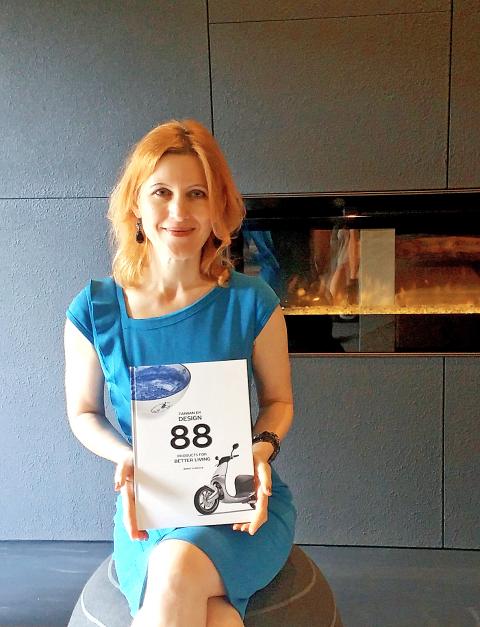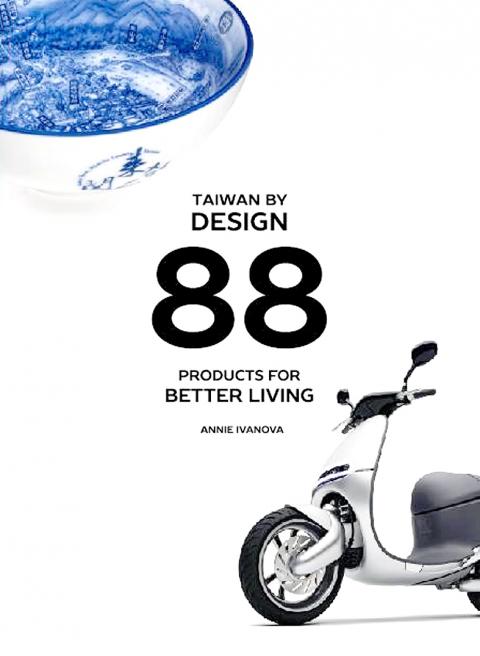The first time Australian curator Annie Ivanova was invited to Taiwan six years ago to be a guest curator at Art Taipei, the annual art fair showcasing works by Taiwanese and international artists, she declined the invitation.
“I turned them down several times,” she says. “I’m busy. Where’s Taipei? What’s Taipei? But they really insisted and I came.”
It’s been a long and fruitful love affair with the country since then, as she became increasingly involved with the local art and design scene, including extensive work with various Aboriginal communities. Earlier this month, as the first resident curator of Home Hotel in Taipei’s Da-an District (大安), Ivanova headed downstairs to the lobby from her suite on the 15th floor for the launch of her book, Taiwan by Design, the first comprehensive English-language book about Taiwanese product design.

Photo: Han Cheung, Taipei Times
It took Ivanova nearly three years to research, write and crowdfund the NT$1.2 million in publication funds, the result of which features 88 products, each focusing on the designer’s personal story and creative process rather than just talking about the product itself.
The book also provides an overview of Taiwanese design history, including European, Chinese, Japanese and Aboriginal influences up to the digital era.
Ivanova says that the initial challenge was finding original designs, as companies often hire famous foreigner designers to brainstorm ideas. While it is Taiwanese designers who complete the project, it is marketed using the foreign designer’s name.

Photo Courtesy of Annie Ivanova
“The focus of the book was to say that Taiwanese designers are very smart and clever and we should be proud of them instead of outsourcing talent from overseas,” she says.
FIRST IMPRESSIONS
When Ivanova first landed in Taiwan Taoyuan International Airport in 2010, she was not impressed by the drab buildings and the under-construction highway en route to Taipei.
“It was so hot and dusty, just concrete and concrete and concrete. I was thinking, ‘What am I doing here? Why did I accept this?’” she says. “But because I’m a curator, I don’t just look at the surface. I go very deep into the roots of why things are. And I met some very interesting people.”
A year later, Ivanova was in Taipei again for the International Design Alliance Congress. This time, she received a commemorative “Trip View Bowl,” a blue-and-white porcelain with intricate aerial panoramic views of Taipei cityscapes painted inside.
“My fascination [with Taiwan design] started with this bowl,” she says. “I told myself I needed to make more connections with the design circle here.”
Ivanova started introducing Taiwanese designers to Australia through her work curating design exhibits at major design festivals. Later, she traveled to various Aboriginal communities, collecting various art and design crafts.
Overall, she found the creative community of Taiwan to be quite dynamic. She believes that part of it has to do with the country’s “convenience culture,” which includes easy access to manufacturing and engineering and extends to transportation and connectivity to the Internet — which is quite different from Australia.
“When people choose convenience as a lifestyle, they’re quite eager to experiment and explore so many new possibilities,” she says.
“When you work with people so engaged with their creative practices who feel so passionate about having a voice as Taiwanese, you want to be proud of that and want to be the connector between this place and the outside world,” she adds.
But with each exhibition, she could only invite one or two designers from Taiwan.
“I thought that was a slow process,” she says. “We need to write a book, so we can introduce 100.”
REAL STORIES
The project grew and started taking longer than Ivanova had expected, but she could not give up because she says Taiwanese designers told her they really needed her to help present them to the international community in way that told the real stories behind the product instead of the usual glossy marketing package.
Ivanova stood firm with her quest for authenticity, personally visiting 350 design companies and studios around the country in two years.
“I did not want any marketing statements or branding information, anything that a marketing department concocted,” Ivanova says. “I made it a rule that I would speak directly to the designers.”
It was not easy to gather the stories behind the inspiration, the perseverance, the crazy ideas that come out of nowhere that lead to an amazing product.
“Language is a problem,” Ivanova says. “Many designers did not speak English. How do we discuss profound ideas when we can’t even have a normal conversation?”
She says she found more trouble communicating with men but usually they had wives or girlfriends who spoke decent English, whom she gives special thanks to in the book. Others were either shy or apprehensive to talking to a foreign woman, she says.
Other than that, it was just keeping things casual and not forcing things, often making several visits to break the cultural barrier.
“I’m a professional curator and I understand the creative process,” she says. “Even if they draw me a picture, I can know the intention or meaning behind the product. It’s translating not just in language, but the creative process and the motivation.”
HOME AT THE HOME HOTEL
The Home Hotel, which incorporates many Aboriginal design elements, found Ivanova through her book and asked her to come stay in the hotel for two months to curate various events and activities.
After being mostly on the road or crashing with a friend during her visits to Taiwan, Ivanova feels that she finally has a home here, for now.
After the book launch, events in the works include a fashion show featuring Aboriginal designers, a pop-up store introducing some of the designers, products featured in the book, and more.
“To work and also be looking for a home in Taipei is hard,” she says. “And now I have a beautiful home at the Home Hotel.”

On April 26, The Lancet published a letter from two doctors at Taichung-based China Medical University Hospital (CMUH) warning that “Taiwan’s Health Care System is on the Brink of Collapse.” The authors said that “Years of policy inaction and mismanagement of resources have led to the National Health Insurance system operating under unsustainable conditions.” The pushback was immediate. Errors in the paper were quickly identified and publicized, to discredit the authors (the hospital apologized). CNA reported that CMUH said the letter described Taiwan in 2021 as having 62 nurses per 10,000 people, when the correct number was 78 nurses per 10,000

As we live longer, our risk of cognitive impairment is increasing. How can we delay the onset of symptoms? Do we have to give up every indulgence or can small changes make a difference? We asked neurologists for tips on how to keep our brains healthy for life. TAKE CARE OF YOUR HEALTH “All of the sensible things that apply to bodily health apply to brain health,” says Suzanne O’Sullivan, a consultant in neurology at the National Hospital for Neurology and Neurosurgery in London, and the author of The Age of Diagnosis. “When you’re 20, you can get away with absolute

May 5 to May 11 What started out as friction between Taiwanese students at Taichung First High School and a Japanese head cook escalated dramatically over the first two weeks of May 1927. It began on April 30 when the cook’s wife knew that lotus starch used in that night’s dinner had rat feces in it, but failed to inform staff until the meal was already prepared. The students believed that her silence was intentional, and filed a complaint. The school’s Japanese administrators sided with the cook’s family, dismissing the students as troublemakers and clamping down on their freedoms — with

As Donald Trump’s executive order in March led to the shuttering of Voice of America (VOA) — the global broadcaster whose roots date back to the fight against Nazi propaganda — he quickly attracted support from figures not used to aligning themselves with any US administration. Trump had ordered the US Agency for Global Media, the federal agency that funds VOA and other groups promoting independent journalism overseas, to be “eliminated to the maximum extent consistent with applicable law.” The decision suddenly halted programming in 49 languages to more than 425 million people. In Moscow, Margarita Simonyan, the hardline editor-in-chief of the